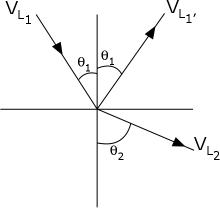Snell's Law
Snell's Law (also known as the Snell-Descartes Law and the Law of Refraction) describes the relationship between angles of incidence and refraction for a wave impinging on an interface between two different mediums with correlating indices of refraction. We derive this formula from the bending of light waves and the speed of wavefronts in two different media. In short, describing the relationship between the angles and velocities of waves.
History
Although, named after the Dutch astronomer Willebrord Snellis (1580-1626), the law was first accurately depicted by Ibn Sahl (c. 940-1000). Sahl was a Muslim physicist of Baghdad who made us of it to work out different shapes of lenses that were able to focus light with no geometric aberrations, known as anaclastic lenses. In later years, the law was rediscovered by Thomas Harriot in 1602, although not published derived a similiar mathematically equivalent form, which remained unpublished during his lifetime. In French, Snell's Law is called "la loi de Descartes" or "loi de Snell-Descartes."
A Mathematical Model
Snell's Law equals the ratio of material velocities V1 and V2 to the sine's of incident (Q1) and refracted (Q2) angles.
- [math]\displaystyle{ \frac{\sin\theta_1}{\sin\theta_2} = \frac{v_1}{v_2} = \frac{\lambda_1}{\lambda_2} = \frac{n_2}{n_1} }[/math]
To manipulate this equation:
- [math]\displaystyle{ {n_1\sin\theta_1} = {n_2\sin\theta_2} }[/math]
Where n1 and n2 are the indices of refraction of the two media and the degrees(thetas) are the angles the incident and transmitted rays , respectively, take on with their normal state.
Examples
A beam of light travels through water and hits a glass surface. The angle between the incident beam and the normal to the glass surface is 23 degrees. The index of refraction of water is 1.33 and the index of refraction of this type of glass is 1.65. What is the refracted angle?
- [math]\displaystyle{ {n_1\sin\theta_1} = {n_2\sin\theta_2} }[/math]
- [math]\displaystyle{ {\sin\theta_2} = \frac{n_1\sin\theta_1}{n_2} }[/math]
- [math]\displaystyle{ {\theta_2} = arcsin\frac{1.33\sin23}{1.65}= 18.4 degrees }[/math]
Connectedness
Snell's Law plays a large role in understanding refraction and the basic topic of light traveling through different media and forums. Although not studied on our final exam, we can still utilize this topic and idea to understand the wavelike movement of light, known as the movement of electromagnetic radiation.
See also
http://www.physicsbook.gatech.edu/Lenses http://www.physicsbook.gatech.edu/Light_Refraction:_Bending_of_light
Further reading
Matter & Interactions, Vol. II: Electric and Magnetic Interactions, 4nd Edition by R. Chabay & B. Sherwood (John Wiley & Sons 2015)
https://www.math.ubc.ca/~cass/courses/m309-01a/chu/Fundamentals/snell.htm
External links
http://www.physicsclassroom.com/class/refrn/Lesson-2/Snell-s-Law
https://en.wikipedia.org/wiki/Snell's_law
References
Matter & Interactions, Vol. II: Electric and Magnetic Interactions, 4nd Edition by R. Chabay & B. Sherwood (John Wiley & Sons 2015)
